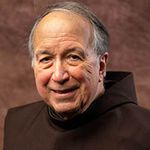Our Lady of Guadalupe: The Franciscan Connection

On December 12, Catholics in the Americas celebrate the Feast of Our Lady of Guadalupe. Franciscans were there at the beginning of this story.
Franciscans and Our Lady of Guadalupe go hand in hand
As the late Dr. Gary Francisco Keller, for years Director of the Hispanic Research Center of Arizona State University, explains, “The Franciscans and Nuestra Señora de Guadalupe go together hand in hand. Franciscans were the first missionaries to come to Nueva España, beginning with Pedro de Gante in 1523 and, in 1524, the Twelve Franciscan Apostles of New Spain. . .The work of these Franciscans marked the beginning of the systematic evangelization of the indigenous peoples of Mexico.”

The old basilica of Our Lady of Guadalupe, Mexico, constructed between 1695–1709 (photo by J. D. Garcia)
Apparitions of Our Lady of Guadalupe to Juan Diego
The Hispanic Research Center at ASU has available on its website an important source document: the “Nican Mopohua,” which narrates the apparitions of Nuestra Señora de Guadalupe to Saint Juan Diego Cuauhtlatoatzin (“Talking Eagle”), on December 9, 10, and the culminating day, December 12, 1531.

Modern depiction of Saint Juan Diego, canonized in 2002 by Pope John Paul II
Franciscans on watch
As Dr. Keller continues: “The Franciscan order was the one on watch during those days. Bishop-designate, and subsequently the first bishop of Mexico, Juan de Zumárraga, OFM (1468–1548), after a couple of days of hesitation, accepted the authenticity of the apparition of the Virgin of Guadalupe to the humble, devout ‘macehualtzin,’ Juan Diego, who had agonized about going to the bishop: ‘Because I am really (just) a man from the country, I am a (porter’s) rope, I am a back-frame, a tail, a wing, a man of no importance: I myself need to be led, carried on someone’s back; that place you are sending me to is a place where I’m not used to going to or spending any time in, my little Virgin, my Youngest Daughter, my Lady, Beloved Maiden.’”

Juan de Zumárraga, OFM (1468–1548), a Basque Spanish friar and first bishop of Mexico, made great efforts to evangelize the indigenous peoples. He is credited with making chocolate a poplar drink among Europeans.
Placing faith in the Holy Mother
As Dr. Keller concludes: “Juan Diego doubted his ability to carry it off with the bishop but placed his faith in the Holy Mother, ‘my little Virgin,’ and Juan de Zumárraga at first was doubtful and skeptical. Ultimately, they both succeeded. The rest is history.”

Interior of the new basilica of Our Lady of Guadalupe in Mexico City, which houses the original image, was constructed between 1974 and 1975 (photo by J. D. Garcia)
Learn more about Our Lady of Guadalupe
Read this fascinating source for yourself—the “Nican Mopohua”—in four languages (Náhuatl [mexicano], Spanish, English, and Italian translations).
Read a beautiful reflection written by Pope Francis several years ago on the continuing significance of Our Lady of Guadalupe (Spanish text first, then English translation).
-----
Main image: The image of Our Lady of Guadalupe in her basilica, Mexico City
Dominic Monti, OFM
Professor of Franciscan Research in the Franciscan Institute of St. Bonaventure University
Dominic V. Monti, OFM, is a Franciscan Friar of Holy Name Province (USA) and currently professor of Franciscan Research in the Franciscan Institute of St. Bonaventure University. He devoted the greater part of his ministry to teaching the History of Christianity, in particular the history of the Franciscan movement. He has contributed two volumes to the Works of St. Bonaventure series and is author of Francis & His Brothers, a popular history of the Friars Minor.

